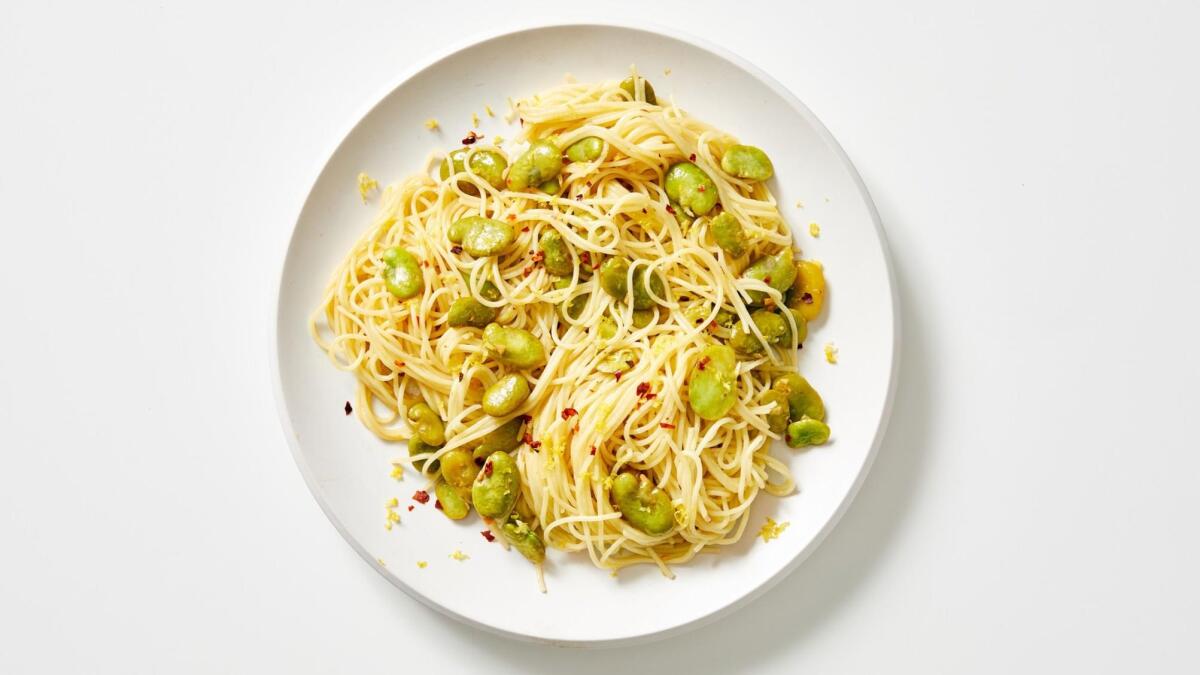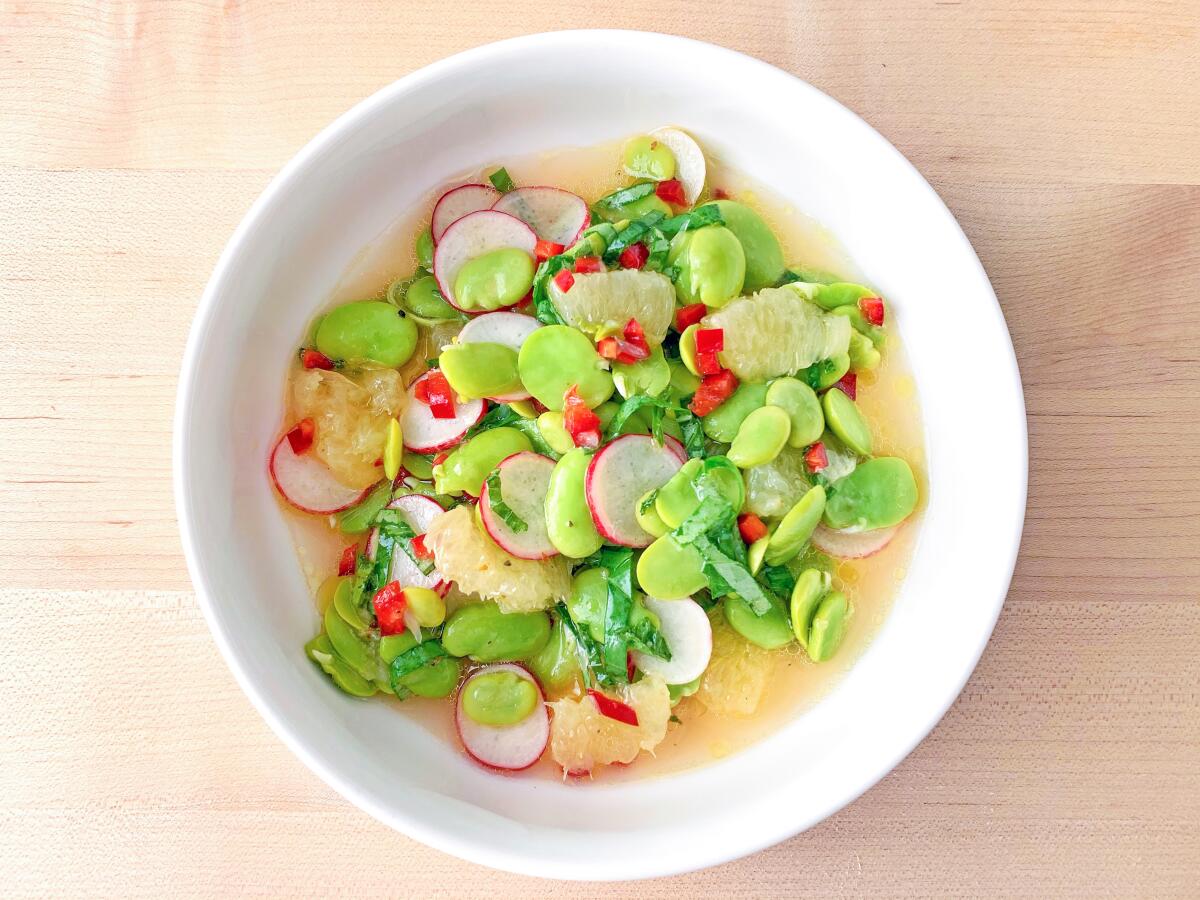How to make the most of spring fava beans

- Share via
A few weeks ago, a friend gave me some of the first fava beans from his garden. Even though the weather lately has felt dreary and wintry, seeing those favas made me realize that, oh yeah, it’s spring now. I set about shelling, skinning and blanching all the favas to put in my freezer until spring weather here caught up with the calendar.
This past week that time finally came, and I was so excited to have all those favas ready to go. I tossed a handful into some pasta for dinner one night and the next night I sautéed some simply with garlic in olive oil to have as a side with a steak. The leftovers from that meal got folded into soft-scrambled eggs the next morning. Though I’m not one to eat leftovers, I can get down with repurposing fava beans over and over; their creamy texture and fresh taste never become a bore.
Get our Cooking newsletter
Get a taste of Los Angeles — and the world — with recipes and kitchen tricks from the L.A. Times’ Cooking newsletter.
You may occasionally receive promotional content from the Los Angeles Times.
If you’ve bought fava beans in the market lately (tip: They’re everywhere right now), get all the shelling and skinning out of the way now, so you can enjoy some of these recipes that use them whenever the mood strikes.
One of my favorite ways to incorporate fava beans is in my Fresh Fava and Merguez Orecchiette With Manchego, and, well, all the selling points are in the name. The verdant sweetness of the favas pairs wonderfully with the spiced merguez (you could use spicy Italian sausage as a substitute if you want) and creamy Manchego cheese. The fava beans sort of mimic the shape of the orecchiette too, nestling neatly in the pasta’s curves as if they’re meant to be there.
For a quicker pasta, I love my Fava Bean Scampi, a vegetarian/vegan spin on the classic that swaps the meaty, sweet favas for shrimp. Plenty of garlic and chile flakes bolster the heartiness of the fava beans while lots of lemon zest adds freshness and acidity to this simple pasta dish.
That same sweet-creamy texture that makes the fava beans a great swap for shrimp also makes them a great candidate for any seafood in my Fresh Fava “Ceviche” with Grapefruit and Chiles. Obviously it’s not a real ceviche, but instead is treated like one, dressing the fava beans in a mélange of herbs, lime juice and fresh chiles studded with larger slices of early-spring radishes and segments of late-winter pomelo — it’s a fantastic dish for this season-straddling time of year.
And if you want something that is the easiest of all, treat the fava beans like hummus and make this Fava Bean Purée that blends the legumes with garlic, olive oil, lemon and toasted cumin. Whether you spread it on toast, dip into it with chips or simply eat it by the spoonful, it’s one of the simplest and tastiest ways to enjoy one of my favorite springtime treats.
Fresh Fava and Merguez Orecchiette With Manchego
Spanish Manchego cheese tops this simple pasta of Moroccan merguez sausage and fresh fava beans inspired by the western Mediterranean. If you can’t find merguez, substitute with sweet or spicy Italian sausage and use harissa paste instead of tomato paste.
Get the recipe.
Cook time: 30 minutes.

Fava Bean Scampi
This recipe is a vegetarian spin on shrimp scampi in which meaty, sweet favas replace the similarly charactered crustaceans. A simple treatment — a little garlic, some chile flakes, a good dose of white wine and a refreshing hit of lemon perfectly highlight the flavor of the beans.
Get the recipe.
Cook time: 15 minutes.

Enjoying this newsletter?
Consider becoming a Times subscriber.
Fresh Fava “Ceviche” With Grapefruit and Chilies
The creamy, meaty texture of fresh fava beans takes its place in this ceviche-like salad bathed in grapefruit juice and olive oil and spiked with Fresno chiles. While the lime juice is optional, it does provide that characteristic jolt of tartness that grapefruit can’t provide.
Get the recipe.
Cook time: 20 minutes, plus 1 hour chilling.

Fava Bean Purée
A food mill lends this fava bean purée a rustic texture perfect for spreading on toast or dipping into with pita chips. But if you don’t have one, pulse the beans in a food processor until they’re as smooth as you like, or crush them by hand with a fork into a chunky mash.
Get the recipe.
Cook time: 45 minutes.

Have a cooking question?
Eat your way across L.A.
Get our weekly Tasting Notes newsletter for reviews, news and more.
You may occasionally receive promotional content from the Los Angeles Times.




